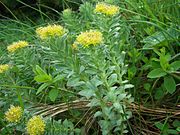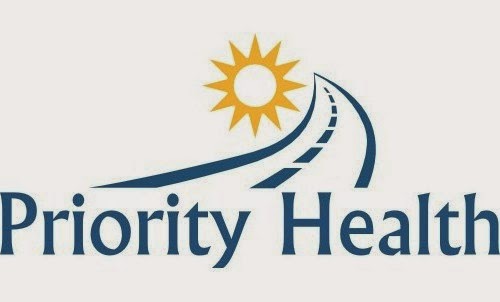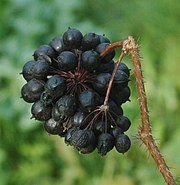Rhodiola rosea
From Wikipedia, the free encyclopedia
| This is an old revision of this page, as edited by Jpsaleeby (talk | contribs) at 14:51, 14 March 2011. It may differ significantly from the current revision. |
| This article needs additional citations for verification. Please help improve this article by adding reliable references. Unsourced material may be challenged and removed. (March 2008) |
| Rhodiola rosea (Roseroot, Golden Root, Arctic Root, Orpin Rose, Rhodiole Rougeâtre) | |
|---|---|
 | |
| Scientific classification | |
| Kingdom: | Plantae |
| (unranked): | Angiosperms |
| (unranked): | Eudicots |
| (unranked): | Core eudicots |
| Order: | Saxifragales |
| Family: | Crassulaceae |
| Genus: | Rhodiola |
| Species: | R. rosea |
| Binomial name | |
| Rhodiola rosea L.[1] | |
| Synonyms | |
| Sedum rosea (L.) Scop. Sedum rhodiola DC. Rhodiola arctica Boriss. Rhodiola iremelica Boriss. Rhodiola scopolii Simonk. Sedum scopolii Simonk. Золотой Корень, Solotoy Koren | |
| Wikimedia Commons has media related to: Rhodiola rosea |
Contents[hide] |
Uses
Rhodiola rosea may be effective for improving mood and alleviating depression. Pilot studies on human subjects[2][3][4] showed that it improves physical and mental performance, and may reduce fatigue.Rhodiola rosea's effects are potentially mediated by changes in serotonin and dopamine levels due to monoamine oxidase inhibition and its influence on opioid peptides such as beta-endorphins,[5] although these specific neurochemical mechanisms have not been clearly documented with scientific studies. However there have been extensive case studies undertaken by Richard P. Brown, MD, associate clinical professor of psychiatry at Columbia University College of Physicians & Surgeons and Patricia L. Gerbarg, MD assistant clinical professor of psychiatry at New York Medical College can be found in their book "The Rhodiola Revolution, printed in 2004 by Rodale, 2468109753. Rhodiola rosea has also been listed as a Complementary and Alternative Treatment in the American Journal of Psychiatry, chapter 104, pages 2147-2183 under Psychiatry Second Edition CAM TREATMENT by authors Allan Tasman, Jerald Kay & Jeffrey A. Lieberman
Rhodiola is included among a class of plant derivatives called adaptogens which differ from chemical stimulants, such as nicotine, and do not have the same physiological effects.
In Russia and Scandinavia, Rhodiola rosea has been used for centuries to cope with the cold Siberian climate and stressful life.[citation needed] Such effects were provided with evidence in laboratory models of stress using the nematode C. elegans,[6] and in rats in which Rhodiola effectively prevented stress-induced changes in appetite, physical activity, weight gain and the estrus cycle.[7]
Rhodiola has been used in traditional Chinese medicine, where it is called hóng jǐng tiān (红景天).
Phytochemicals and potential health effects
The dried rhizomes contained essential oil with the main chemical classes: monoterpene hydrocarbons, monoterpene alcohols and straight chain aliphatic alcohols were the most abundant volatiles detected in the essential oil, and a total of 86 compounds were identified (Rohloff, 2002). Geraniol was identified as the most important rose-like odor compound besides geranyl formate, geranyl acetate, benzyl alcohol and phenylethyl alcohol. Its oxygenated metabolite Rosiridol is an aglycon of Rosiridin (Kurkin et al., 1985a; Kurkin and Zapesochnaya, 1986b) - one of the most active constituents of Rhodiola in bioassay guided fractionation of Rhodiolathe extract.[8] Rosiridin was found to inhibit monoamine oxidases A and B in vitro implying its potential beneficial effect in depression and senile dementia.[8] More than 50 polar compounds were isolated from the water alcoholic extracts, they are: monoterpene alcohols and their glycosides, cyanogenic glycosides, phenylethanoids and phenylpropanoids, flavonoids, aryl glycosides, proanthocyanidins and other gallic acid derivatives. (Zapeschnaya, and Kurkin, 1983, 1983; Kurkin et al., 1985a; Kurkin, and Zapesochnaya, 1986a,b; Ganzera et al., 2001; Tolonen et al.,2003; Saratikov and Krasnov, 2004; Akgul et al., 2004; Ma et al.2006, Yousef et al., 2006, Ali et al.,2008; Avula et al., 2008).Rhodiola rosea contains a variety of compounds that may contribute to its effects,[9] including the class of rosavins which include rosavin, rosarin, and rosin. Several studies have suggested that the most active components are likely to be rhodioloside and tyrosol,[10] with other components being inactive when administered alone, but showing synergistic effects when a fixed combination of rhodioloside, rosavin, rosarin and rosin was used.[11]
Although rosavin, rosarin, rosin and salidroside (and sometimes p-tyrosol, rhodioniside, rhodiolin and rosiridin) are among suspected active ingredients of Rhodiola rosea, these compounds are mostly polyphenols for which no physiological effect in humans is proved to prevent or reduce risk of disease.[12]
Although these phytochemicals are typically mentioned as specific to Rhodiola extracts, there are many other constituent phenolic antioxidants, including proanthocyanidins, quercetin, gallic acid, chlorogenic acid and kaempferol.[13][14]
While animal tests have suggested a variety of beneficial effects for Rhodiola rosea extracts[15] there is scientific evidence only for depression as a benefit in humans. A clinical trial showed significant effect for a Rhodiola extract in doses of 340–680 mg per day in male and female patients from 18 to 70 years old with mild to moderate depression.[16]
The effect of Rodiola Rosea promoting the release of NO from RPCSMC and RAEC was correlated with the effect of Rodiola Rosea to resist senility.[17]
Rhodiola rosea extract SHR-5 exerts an anti-fatigue effect that increases mental performance, particularly the ability to concentrate in healthy subjects (Darbinyan et al., 2000; Spasov et al.,2000b; Shevtsov et al., 2003) and burnout patients with fatigue syndrome (Olsson et al., 2009). Rhodiola significantly reduced symptoms of fatigue and improved attention after four weeks of repeated administration (Olsson et al., 2009).
Olsson, E.M.G., von Schéele, B., Panossian, A.G., 2009. A randomized double-blind placebo controlled parallel group study of SHR-5 extract of Rhodiola rosea roots as treatment for patients with stress related fatigue. Planta medica 75,105-112.
Studies on whether Rhodiola improves physical performance have been inconclusive, with some studies showing some benefit,[18] while others show no significant difference.[19]
Inhibitory activities against HIV-1 protease[20]
Dosage
Rhodiola rosea extract is mainly used in the form of capsules or a tablet, though tinctures are also available. The capsules and tablets often contain 100 mg of a standardized amount of 3 percent rosavins and 0.8–1 percent salidroside because the naturally occurring ratio of these compounds in Rhodiola rosea root is approximately 3:1. Authentication as well as potency of golden root crude drug materials and standardized extracts thereof are carried out with validated RP-HPLC analyses to verify the content of the marker constituents salidroside, rosarin, rosavin, rosin and rosiridin.[21] However, as with many plant-based remedies, an approved dosage range in relation to the active constituents has officially not been established. In these cases, dosage recommendations of the individual manufacturers should be followed.A typical dosage is one or two capsules or tablets daily; one in the morning and when taking two, one in the early afternoon. Rhodiola rosea should be taken early in the day because for some it can interfere with sleep. Others can take it in the evening with no effect on sleep patterns. If a user becomes overly activated, jittery or agitated then a smaller dose with very gradual increases may be needed. It is contraindicated in excited states.[citation needed]
The dose may be increased to 200 mg three times a day if needed. A high dose is considered to be daily intakes of 1,000 mg and above.[citation needed]
Rhodiola rosea may be beneficial to increase energy and mental performance for people suffering from Hashimoto's disease.[citation needed]
In a 2007 clinical trial from Armenia, total effective doses were in the range of 340–680 mg per day for people aged 18 to 70. No side effects were demonstrated at these doses in the treatment of mild to moderate depression.[22]
See also
References
- ^ "Rhodiola rosea - Plants For A Future database report". www.pfaf.org. http://www.pfaf.org/user/Plant.aspx?LatinName=Rhodiola%20rosea. Retrieved 2008-02-23.
- ^ Shevtsov VA, Zholus BI, Shervarly VI, et al. (Mar 2003). "A randomized trial of two different doses of Rhodiola rosea extract versus placebo and control of capacity for mental work". Phytomedicine 10 (2-3): 95–105. doi:10.1078/094471103321659780. PMID 12725561.
- ^ Darbinyan V, Kteyan A, Panossian A, Gabrielian E, Wikman G, Wagner H (Oct 2000). "Rhodiola rosea in stress induced fatigue—a double blind cross-over study of a standardized extract with a repeated low-dose regimen on the mental performance of healthy physicians during night duty". Phytomedicine 7 (5): 365–71. PMID 11081987.
- ^ Ha Z, Zhu Y, Zhang X, et al. (Sep 2002). "[The effect of rhodiola and acetazolamide on the sleep architecture and blood oxygen saturation in men living at high altitude]" (in Chinese). Zhonghua Jie He He Hu Xi Za Zhi 25 (9): 527–30. PMID 12423559.
- ^ Gregory S. Kelly, ND, (2001). "Rhodiola rosea: a possible plant adaptogen.". Alternative Medicine Review 6 (3): 293–302. PMID 11410073.
- ^ Wiegant FA, Surinova S, Ytsma E, Langelaar-Makkinje M, Wikman G, Post JA (Jun 2008). "Plant adaptogens increase lifespan and stress resistance in C. elegans". Biogerontology 10 (1): 27–42. doi:10.1007/s10522-008-9151-9. PMID 18536978.
- ^ Mattioli L, Funari C, Perfumi M (May 2008). "Effects of Rhodiola rosea L. extract on behavioural and physiological alterations induced by chronic mild stress in female rats". Journal of Psychopharmacology (Oxford) 23 (2): 130–42. doi:10.1177/0269881108089872. PMID 18515456.
- ^ a b van Diermen, 2009 Monoamine oxidase inhibition by Rhodiola rosea L. roots.
- ^ Kucinskaite A, Briedis V, Savickas A (2004). "[Experimental analysis of therapeutic properties of Rhodiola rosea L. and its possible application in medicine"] (in Lithuanian). Medicina (Kaunas) 40 (7): 614–9. PMID 15252224. http://medicina.kmu.lt/0407/0407-02l.pdf.
- ^ Mao Y, Li Y, Yao N (Nov 2007). "Simultaneous determination of salidroside and tyrosol in extracts of Rhodiola L. by microwave assisted extraction and high-performance liquid chromatography". J Pharm Biomed Anal 45 (3): 510–5. doi:10.1016/j.jpba.2007.05.031. PMID 17628386.
- ^ Panossian A, Nikoyan N, Ohanyan N, et al. (Jan 2008). "Comparative study of Rhodiola preparations on behavioral despair of rats". Phytomedicine 15 (1-2): 84–91. doi:10.1016/j.phymed.2007.10.003. PMID 18054474.
- ^ Boudet AM (2007). "Evolution and current status of research in phenolic compounds". Phytochemistry 68 (22-24): 2722–35. doi:10.1016/j.phytochem.2007.06.012. PMID 17643453.
- ^ Yousef GG, Grace MH, Cheng DM, Belolipov IV, Raskin I, Lila MA (Nov 2006). "Comparative phytochemical characterization of three Rhodiola species". Phytochemistry 67 (21): 2380–91. doi:10.1016/j.phytochem.2006.07.026. PMID 16956631.
- ^ Liu Q, Liu ZL, Tian X (Feb 2008). "[Phenolic components from Rhodiola dumulosa]" (in Chinese). Zhongguo Zhong Yao Za Zhi 33 (4): 411–3. PMID 18533499.
- ^ Perfumi M, Mattioli L (Jan 2007). "Adaptogenic and central nervous system effects of single doses of 3% rosavin and 1% salidroside Rhodiola rosea L. extract in mice". Phytother Res 21 (1): 37–43. doi:10.1002/ptr.2013. PMID 17072830.
- ^ Darbinyan V, Aslanyan G, Amroyan E, Gabrielyan E, Malmström C, Panossian A (2007). "Clinical trial of Rhodiola rosea L. extract in the treatment of mild to moderate depression". Nord J Psychiatry 61 (5): 343–8. doi:10.1080/08039480701643290. PMID 17990195.
- ^ Effect of Rodiola on level of NO and NOS in cultured rats penile corpus cavernosum smooth muscle cell and artery endothelium cell Kong X., Shi F., Chen Y., Lu H., Yao M., Hu M. Chinese Journal of Andrology 2007 21:10 (6-11)
- ^ De Bock K, Eijnde BO, Ramaekers M, Hespel P (Jun 2004). "Acute Rhodiola rosea intake can improve endurance exercise performance". Int J Sport Nutr Exerc Metab 14 (3): 298–307. PMID 15256690.
- ^ Walker TB, Altobelli SA, Caprihan A, Robergs RA (Aug 2007). "Failure of Rhodiola rosea to alter skeletal muscle phosphate kinetics in trained men". Metab Clin Exp. 56 (8): 1111–7. doi:10.1016/j.metabol.2007.04.004. PMID 17618958.
- ^ Screening of Korean plants against human immunodeficiency virus type 1 protease Min B.S., Bae K.H., Kim Y.H., Miyashiro H., Hattori M., Shimotohno K. Phytotherapy Research 1999 13:8 (680-682)
- ^ Ganzera M, Yayla Y, Khan IA. (2001). “Analysis of the marker compounds of Rhodiola rosea L. (golden root) by reversed phase high performance liquid chromatography”. Chem Pharm Bull (Tokyo) 49(4): 465-7. PMID: 11310675
- ^ Darbinyan, V.; Aslanyan, G.; Amroyan, E.; Gabrielyan, E.; Malmstroumlm, C.; Panossian, A. Clinical trial of Rhodiola rosea L. extract SHR-5 in the treatment of mild to moderate depression Nordic Journal of Psychiatry, Volume 61, Issue 5 2007 , pages 343–348 ; accessed Dec 2008
External links
- Flora of the Canadian Arctic Archipelago [1]
- Science News Online, Warming to a Cold War Herb
- Third Age, ThirdAge: Rhodiola rosea
- American Botanical Council, Rhodiola rosea: A Phytomedicinal Overview
- Whole Health MD, Reference Library
- Alternative Medicine, The Herb that Came In from the Cold
- Wilderness Medical Society, Lack of Effect of Rhodiola on Hypoxemia and Oxidative Stress
- Swedish Medical Center, Acute Mountain Sickness
Further reading
- Richard P. Brown, MD & Patricia L. Gerbarg with Barbara Graham. “The Rhodiola Revolution" Rodale Press, 2004. A discussion of the benefits of Rhodiola rosea.
- Saleeby,M.D., J.P., Keefer, A., "Wonder Herbs: A guide to three adaptogens", Xlibris, 2006. Entire chapter devoted to R. rosea.










